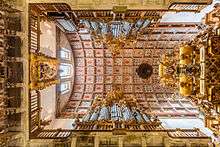Monastery of San Martiño Pinario





The monastery of San Martiño Pinario (San Martín Pinario in Castilian) is a former Benedictine monastery in the city of Santiago de Compostela, Galicia, Spain.
Little remains of the original medieval buildings, as the monastery has been largely rebuilt since the sixteenth century. The monastery was closed in the nineteenth century in the Ecclesiastical Confiscations of Mendizábal. The buildings currently house a seminary.
History
It originated in a chapel dedicated to Santa Maria called the Corticela which was demolished in the late ninth century, except the chapel, which today is part of the Cathedral of Santiago, when King Afonso III the Great and the Sisnando bishop cathedral began the new fabric. Thus, around the year 899, was built this monastery where Benedictine monks moved the old chapel. This monastery was later replaced by another monastery whose church was consecrated in 1102 by Bishop Diego Gelmírez, but not much remains of that era.
Throughout the Middle Ages the monastery grew so that by the end of the fifteenth century monastery became the richest and most powerful of Galicia. This led to it was almost completely rebuilt from the sixteenth century. From that century was the most powerful monastery under his authority Galicia taking most Galician monasteries. With the seizure in the year 1835 was devoted to various functions and since 1868 it became the seat of the seminar most of the Archdiocese of Santiago.
Today it continues as seminary Compostela and site of the Department of Theology and Social Work. Formerly a part of the building was used as a residence hall, but at the end of the academic year 2007-2008 was closed in order to carry out reforms intraestructurales, which topped and give way to reopen for the 2011-2012 academic year RUSMP.
Architecture
The facade
The facade has an altarpiece structure and shows the figures of the Virgin and Child and saints Benedictine abbots. The Eternal Father chairs the triangular pediment. St. Martin of Tours completes the set on top with a classic representation: on horseback and dividing his cloak to shelter a beggar.
The main facade is oriented to the south and have front gardens that are the Plaza de la Inmaculada. It was designed by Gabriel de las Casas and her four Doric columns supporting an entablature with pinnacles. Above the door is a picture of San Benito, a large shield of Spain and San Martin riding high.
The church
The church, completed in 1652, is the work of Matthew Lopez and Gonzalez de Araújo and opens onto the square that bears the name of the monastery, which lowers her face. The plan of the church has a single nave covered with a barrel vault with lacunar false. Six side-chapels open onto the nave and communicate with each other and have the same kind of dome as the nave. The crossing is illuminated by a dome in half. The choir stalls, Baroque, is the work of Matthew de Prado and the three largest altar pieces, along with the Relief Chapel of the same temple, are the work of Fernando de Casas Novoa, creating here one of the most exquisite Baroque nationally and internationally.
Currently, this building has enabled part as a museum of religious art, which is accessed through the door of the church of St. Martin, and is distinguished as one of the best in the community. You can visit also the temple itself, the statio (sacristy), the sacristy, the former printing, the pharmacy, the chapel of the relics (theca) or the Renaissance choir of the Cathedral of Santiago de Compostela, and various collections of gold, ivory or liturgical vestments.
The Cloisters
The monastery has two cloisters. The largest was built in 1636 by Bartolome Fernandez Lechuga (the author of the transept of the church), and continued by José Peña de Toro and Fernando Casas y Novoa, who finished in 1743 .
External links
| Wikimedia Commons has media related to Monastery of San Martiño Pinario. |
Coordinates: 42°52′55″N 8°32′40″W / 42.88194°N 8.54444°W